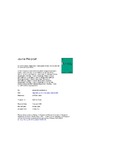Innovative catalyst integration on transparent silicone microreactors for photocatalytic applications

Fecha
2022Autor
Versión
Acceso abierto / Sarbide irekia
Tipo
Artículo / Artikulua
Versión
Versión aceptada / Onetsi den bertsioa
Identificador del proyecto
Impacto
|
|
10.1016/j.cattod.2020.05.058
Resumen
Reproducible and controllable incorporation and immobilization of catalysts and other active particles onto silicone microreactor channels is still challenging. In this work, we present an innovative fabrication protocol to attain affordable, custom-designed photocatalytic microreactors in a fast and simple manner. In this protocol, a 3D-printed ABS microreactor mold is first dip-coated with the ...
[++]
Reproducible and controllable incorporation and immobilization of catalysts and other active particles onto silicone microreactor channels is still challenging. In this work, we present an innovative fabrication protocol to attain affordable, custom-designed photocatalytic microreactors in a fast and simple manner. In this protocol, a 3D-printed ABS microreactor mold is first dip-coated with the photocatalyst, and subsequently, the catalytic layer is transferred onto the microchannel walls by indirect immobilization during the silicone casting and scaffold removal step. Serpentine-shaped microreactors have been satisfactorily fabricated with Au@POM-impregnated TiO2 nanoparticles (Au@POM/TiO2; Au 0.18 % w/w, POM: H3PW12O40) as the integrated photocatalytic layer. The suitability of our fabrication method has been validated on the basis of the excellent photocatalytic performance shown by the microreactors in a model test reaction such as the continuous-flow photoreduction of 4-nitrophenol to 4-aminophenol with NaBH4 and monitored by UV-Vis spectroscopy. [--]
Materias
3D printing,
Silicone microreactors,
Photocatalysis,
Au nanoparticles,
Polyoxometalates
Editor
Elsevier
Publicado en
Catalysis Today 383 (2022) 164-172
Departamento
Universidad Pública de Navarra/Nafarroako Unibertsitate Publikoa. Institute for Advanced Materials and Mathematics - INAMAT2
Versión del editor
Entidades Financiadoras
Financial support from Gobierno de Navarra (grants PC025-26 and PI030) an Spanish Ministerio de Ciencia, Innovación y Universidades, and the European Regional Development Fund (ERDF/FEDER) (grant RTI2018-096294-B-C31) is gratefully acknowledged. I.P. and S.R. thank Obra Social la Caixa, Fundación Caja Navarra and Universidad Pública de Navarra (UPNA) for their research contracts in the framework of the programs 'Ayudas Postdoctorales' and 'Captación del Talento'. L.M.G. thanks Banco de Santander and UPNA for their financial support under 'Programa de Intensificación de la Investigación 2018' initiative. Centro Tecnológico Lurederra is gratefully acknowledged for its partnership in the project FOREST (PC025-026).






